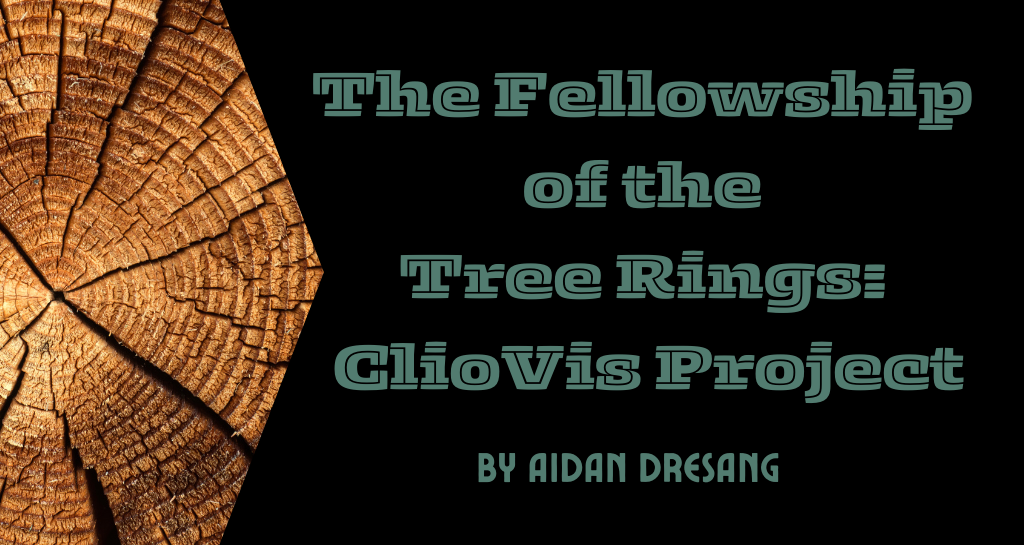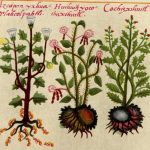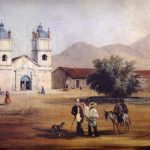
My grandparents and I looked down onto the vast Sonoran Desert from Mount Lemmon, north of Tucson, Arizona. At nearly 8,000 feet, quaking aspen, cottonwood, alder, and other tree species surrounded us—a stark contrast with the desert below. An audio guide played on my grandma’s Samsung Galaxy as we took in our surroundings. The voice, who I later learned is a singer named Joey Burns, told us about how researchers at the University of Arizona learned that fires are essential to healthy forests by studying tree rings.[1] Burns continued, “Every tree you see around you has the story of its life hidden in its rings.”[2]
Fast forward six years: Dr. Erika Bsumek sends me a podcast called The Fellowship of the Tree Rings, which explores connections between tree rings, hurricanes, the Golden Age of European Piracy, and even the Sugar Revolution.[3] The podcast is based on research from Valarie Trouet, Marta Domínguez-Delmás, and Grant Harley, reconstructing 500 years of Caribbean hurricane records by studying tree rings.[4] It is a remarkable resource that sheds light on the intersection between climate science and history.

Source: Wikimedia Commons
Meeting at the Second American Dendrochronology Conference in Tucson, Arizona, near Mount Lemmon, the three researchers discussed how shipwreck records and tree ring data could be combined to reconstruct a history of hurricanes in the Caribbean.[5] After successfully reconstructing a chronology, the researchers observed a dip in the number of hurricanes between 1645 and 1715.[6] Trouet noticed that this correlates with what is known as the “Maunder Minimum,” a period of low solar radiation.[7]
This made sense—less solar radiation meant cooler temperatures, which is not the ideal environment for forming hurricanes. Hurricanes thrive in environments with warm water and air.[8] But why is the connection between the “Maunder Minimum” and a period of fewer hurricanes significant? The work of Trouet, Domínguez-Delmás, and Harley illustrates the ability of climate proxies to reveal new perspectives on history that would go otherwise unnoticed. Assistant Professor of History Melissa Charenko, whose research was influential in the creation of my project, defines climate proxies well in another article for Not Even Past. She writes:
Proxies are things like tree rings, ice cores, pollen, and lake sediments. They are material traces that indirectly reflect the climates of the past. For example, scientists can use tree rings to reconstruct past temperature and moisture. Or they can use the air bubbles trapped in ice to study the composition of the atmosphere through time.[9]
In the case of The Fellowship of the Tree Rings, researchers used tree rings as a climate proxy to reconstruct a chronology of hurricanes in the Caribbean. Their use of climate proxies is especially interesting because of the subsequent historical connections they made using the chronology.
When looking at the larger history of the Caribbean, the lull in hurricane activity can be connected with an influx in Caribbean maritime activity, specifically within the context of the Sugar Revolution and Golden Age of European Piracy, which lasted roughly from 1650 to 1730.[10] The Fellowship of the Tree Rings asserts that the sun—and, more broadly, the environment—played a vital role in both shaping and uncovering our past. By connecting solar phenomena like the “Maunder Minimum” to historical periods such as the Sugar Revolution, The Fellowship of Tree Rings illuminates the environment’s unseen hand in transforming human history. Furthermore, by understanding how Trouet, Domínguez-Delmás, and Harley used tree rings to provide insight into a larger Caribbean history, we can reconsider our natural surroundings as a burgeoning resource in explaining our past.

Source: Library of Congress, LC-USZ62-72094 DLC
As I think back to my trip to the top of Mount Lemmon, I did not understand how impactful the story of a tree’s life might be to understanding human history. Human history is all too often framed as something separate from environmental history when really it should be seen as inextricable. The work of Trouet, Domínguez-Delmás, and Harley demonstrates that the environment and human history are forever intertwined.
All of this inspired me to build a timeline that contextualized their research.
For this project, I took The Fellowship of the Tree Rings podcast episode and mapped information from it onto an interactive timeline using ClioVis—an interactive timeline software that allows you to chart historical (or nonhistorical) concepts, events, and themes, emphasizing connections between them. The Fellowship of the Tree Rings lent itself well to the ClioVis format as the story contains various historical and scientific connections. After mapping the RadioLab episode, I went through the timeline and added my own events, connections, and eras to give greater context to the story.
While building this timeline, I became increasingly fascinated in how interconnected piracy, the Sugar Revolution, and hurricanes were. I learned about the complex relationship between empires and piracy. Although they were outlaws operating in maritime spaces, pirates paradoxically facilitated the expansion of empires by assisting in territorial conquests.[11] This took place against the backdrop of the Sugar Revolution, where imperial powers scrambled to gain control of lucrative trading ports and colonies. European states sought to extract as much wealth as possible from the Caribbean. To do so, they plundered indigenous communities and violently exploited enslaved African labor.[12]
As millions of enslaved Africans were forcibly taken by these empires from Africa to the Caribbean, some African people were able to escape and join pirate crews.[13] This all took place during a historic period of low hurricane activity. When the idea of the climate shaping these events is added to the picture, it changes things. Did the significantly reduced threat of hurricanes to ships propel both the Sugar Revolution and piracy? In my timeline, I attempt to map out this complex history and answer that question.
As the timeline shows, contextualizing The Fellowship of the Tree Rings demonstrates the complex relationship between the “Maunder Minimum,” hurricanes, the Golden Age of European Piracy, and the Sugar Revolution. Between 1650 and 1715, a lull in hurricane activity associated with the “Maunder Minimum” transformed the environment. As maritime trade increased, ships simultaneously faced a comparatively lower threat of hurricanes than in other periods in history. This meant that hurricanes did not play their traditional role in the Caribbean ecosystem—their check on human activity was temporarily weakened.
Why is this important? Between 1650 and 1715, European colonial powers cemented their position in the Americas through the Sugar Revolution. European ships transported a massive amount of wealth—including enslaved African people—in the triangular trade, which helped fund Europe’s industrial revolution.[14] The Fellowship of Tree Rings introduces the environment as playing a role in accelerating that process, sinking fewer fleets because of hurricane activity. This connection reveals how historical periods are impacted by changes in climate, providing us with new understandings of the larger societal shifts that come with them.
Valerie Trouet, Marta Domínguez-Delmás, and Grant Harley make use of tree rings as climate proxies to establish these connections and illustrate the value of studying human history in terms of the environment. Their study joins the growing field of paleoecologists who seek to learn about our climatic history from the natural world around us. In addition to learning about climate history as it is narrowly understood, these scholars are studying the environment to learn about systems of power, like the rise of the Sugar Revolution and its relationship with the Golden Age of European Piracy.
Historians often leave out an important voice in their stories: the planet. In The Fellowship of the Tree Rings, we hear about the environment’s role in one of the most formative time periods in the Western Hemisphere, the Sugar Revolution and the Golden Age of European Piracy. As we enter an era defined by human-made climate change, it is even more important to understand the historical relationship between social changes and the climate. Trouet, Domínguez-Delmás, and Harley tell us to first look at the environment itself.
Now, when I reflect on my work contextualizing The Fellowship of Tree Rings, I think again about what Joey Burns meant when he said, “Every tree you see around you has the story of its life hidden in its rings.”[15] A tree’s rings are not just the story of its life but a perspective on the history of the world around it.
Aidan Dresang is an undergraduate history major studying to become a public high school history teacher. He is interested in environmental history, resistance movements, and histories of the Americas. As a future history teacher, Aidan hopes to teach history critically and bridge the community-classroom divide. He is currently a ClioVis intern.
[1] Joey Burns, “Mt. Lemmon Science Tour” (Audio Tour, University of Arizona College of Science, 2015).
[3] Latif Nasser and Lulu Miller, “The Fellowship of the Tree Rings,” RadioLab, accessed October 25, 2023, https://www.radiolab.org/podcast/fellowship-tree-rings/transcript.
[4] Valerie Trouet, Tree Story: The History of the World Written in Rings (Baltimore: Johns Hopkins University Press, 2022), 203.
[7] Nasser and Miller, “The Fellowship of the Tree Rings.”
[8] Hackney Blackwell, Amy, and Elizabeth P. Manar, eds. “Hurricane.” In U-X-L Encyclopedia of Weather and Natural Disasters, 398–407. Farmington Hills, MI: Gale, 2016.
[9] Charenko, Melissa. “IHS Climate in Context: Climate by Proxy.” Not Even Past, December 15, 2020. https://notevenpast.org/ihs-climate-in-context-climate-by-proxy/.
[10] Nasser and Miller, “The Fellowship of the Tree Rings.”
[11] Robert C. Ritchie, Captain Kidd and the War against the Pirates (Cambridge (Mass.): London Harvard University Press, 1986), 15.
[12] Richard S. Dunn, Sugar, and Slaves: The Rise of the Planter Class in the English West Indies, 1624-1713 (Chapel Hill, UNITED STATES: Omohundro Institute of Early American History & Culture, 1972), 50–68.
[13] Aimee Wodda, “Piracy in Colonial Era,” in The Encyclopedia of Criminology and Criminal Justice, 1st ed. (Wiley, 2013), 2, https://doi.org/10.1002/9781118517383.wbeccj528.
[14] Barry W. Higman, “The Sugar Revolution,” The Economic History Review 53, no. 2 (2000): 213.
[15] Burns, “Mt. Lemmon Science Tour.”
The views and opinions expressed in this article or video are those of the individual author(s) or presenter(s) and do not necessarily reflect the policy or views of the editors at Not Even Past, the UT Department of History, the University of Texas at Austin, or the UT System Board of Regents. Not Even Past is an online public history magazine rather than a peer-reviewed academic journal. While we make efforts to ensure that factual information in articles was obtained from reliable sources, Not Even Past is not responsible for any errors or omissions.



